 |
|
 |
| |
發行人:黃建璋所長 編輯委員:曾雪峰教授 主編:林筱文 發行日期:2021.12.30 |
| |
|
 |
|

本所李君浩教授榮膺「2022 SPIE Fellow」,特此恭賀!

本所林恭如教授與陽明交通大學合作研究成果之論文獲選發表於「美國光學學會Spotlight
on Optics」,特此恭賀!
論文名稱:Ultrafast
2 × 2 green micro-LED array for optical
wireless communication beyond 5 Gbit/s
相關網址:https://www.osapublishing.org/spotlight/summary.cfm?id=460138

本所蘇國棟教授榮獲「中華民國光電學會110年度張明文青年光學科技獎」,特此恭賀!
 本所林晃巖教授指導碩士生張乃元同學榮獲「
本所林晃巖教授指導碩士生張乃元同學榮獲「 The 12th International Conference on 3D Systems and Applications (3DSA 2021) - Best Poster Paper Award」,特此恭賀!

本所林恭如教授指導碩士生翁瑞鴻同學榮獲「中華民國光電學會110年度碩士論文獎」,特此恭賀!
 本所教授指導碩、博士生榮獲「
本所教授指導碩、博士生榮獲「 OPTIC 2021
Student Paper Award」,獲獎資訊如下,特此恭賀!
|
學生姓名 |
獎項 |
指導教授 |
|
Bhaskar Jyoti Borah(巴卡地)
(博士生) |
OPTIC 2021 Student Paper Award – Oral
論文名稱:Sub-Minute Multicolor Giga-Pixel Nonlinear Optical Mesoscope with >30 M/s Effective Pixel Rate |
孫啟光 |
|
曾耀賝
(碩士生) |
OPTIC 2021 Student Paper Award – Oral
論文名稱:H&E-enhanced nonlinear optical microscopy to rapidly assess glioma border in human brain |
孫啟光 |
|
錢子群
(碩士生) |
OPTIC 2021 Student Paper Award – Oral
論文名稱:One-bit Transmission Analyzation of asymmetric-arm Silicon Photonic Mach–Zehnder Modulator |
林恭如 |
|
張雨倢
(碩士生) |
OPTIC 2021 Student Paper Award – Oral
論文名稱:Analysis of TM polarization ratio in UVC-LEDs with 3D k•p method by considering random alloy fluctuation |
吳育任 |
|
薛陸清
(碩士生) |
OPTIC 2021 Student Paper Award – Oral
論文名稱:Development of Integrated Optoelectrical Amplifier and High Resolution Smart Thermal Sensor with Light-Emitting Transistors |
吳肇欣 |
|
蔡侑男
(博士生) |
OPTIC 2021 Student Paper Award – Poster
論文名稱:Cellular imaging with a customized spectral-domain OCT system and an in-house developed cell incubator |
李翔傑 |
|
張浩陞
(碩士生) |
OPTIC 2021 Student Paper Award – Poster
論文名稱:Design and Realization of Wide Field-of-view 3D MEMS LiDAR |
蘇國棟 |
|
|
 |
|
 |
|
| |
|
|
|
|
|
 |
News on Optoelectronics
2021 Queen Elizabeth Prize for Engineering
GIPO is delighted to share the news of 2021 Queen Elizabeth Prize. Several of GIPO’s faculty members, including Prof. Jian-Jang Huang, Prof. Chao-Hsin Wu and Prof. Yuh-Renn Wu, have long term collaborations and interactions with the recipients, Prof. Nick Holonyak Jr, Prof. Russell Dupuis, Dr. M. George Craford and Prof. Shuji Nakamura.
LED lighting development wins 2021 Queen Elizabeth Prize for Engineering.
Isamu Akasaki, Shuji Nakamura, Nick Holonyak Jr, M. George Craford and Russell Dupuis have been awarded the world's most prestigious engineering accolade.
First awarded in 2013 in the name of Her Majesty The Queen, the QEPrize exists to celebrate ground-breaking innovation in engineering. The 2021 winners were announced on February 2 by Lord Browne of Madingley, Chairman of the Queen Elizabeth Prize for Engineering Foundation.
Solid-state lighting technology has changed how we illuminate our world. It can be found everywhere from sports stadiums, parking garages, inside and outside commercial buildings, homes, digital displays and computer screens and cell phones to hand-held laser pointers, automobile headlights and traffic lights. Today’s high-performance LEDs are used in efficient solid-state lighting products across the world and are contributing to the sustainable development of world economies by reducing energy consumption.
Visible LEDs are now a global industry predicted to be worth over $108 billion by 2025 through low-cost, high-efficiency lighting. They are playing a crucial role in reducing carbon dioxide emissions, consuming significantly less energy and producing 90% less heat than incandescent lighting, and their large-scale use reduces the energy demand required to cool buildings. For this, they are often referred to as the ‘green revolution’ within lighting.
Link
News referred from:
https://qeprize.org/winners
|
 |
|
|
|
|
|
|
|
|
|
 |
|
| |
|
 |
|
林建中教授於2002年取得美國史丹佛大學電機工程博士學位,指導教授為Professor James Harris。其博士論文主要在半導體光電元件與微機電結構(MEMS)的單石化整合(monolithic integration)上。畢業之後投入美國相關的新創公司工作,包括E2O Communication Inc.以及Santur Corp.兩家新創公司。期間由一般的研發工程師逐步升至相關的經理職位。工作範圍包括了長波長VCSEL雷射以及波長可調變之DFB雷射陣列。這些元件,在當時不但屬於新穎技術,也是業界極為需要商品化的關鍵光通訊元件。2009年林博士返國加入國立交通大學光電學院光電系統研究所,重新返回學術單位,進行相關的光電元件研究。之後在2021年8月加入國立臺灣大學電機系及光電工程學研究所任教。
林教授的研究領域著重於新穎光電元件的製作與設計。包括高效率量子點發光與光偵測元件、微小化發光二極體應用於微顯示螢幕、多重發光之顏色轉換層應用於光電元件等等方向。涵蓋了相關的材料研究以及元件的製程與封裝。同時也對於如何延長新穎材料的使用壽命,進行廣泛而深入的探討。
林教授相關的研究成果多發表於國際頂尖會議與學術期刊,如:CLEO、IEEE IPC、IEEE PVSC、Advanced Functional Materials、IEEE JSTQE、Optics Express等,歷年來已發表超過230篇的相關論文。林教授是科技部優秀年輕學者研究計畫得主,同時也於2020年榮獲美國光學學會會士的榮譽。
林教授目前參與的計畫以前瞻顯示計畫、矽光子同調通訊計畫為主,並且主持科技部個人型研發計畫,著力於利用量子點強化傳統半導體太陽能電池元件的功能。
在教學研究之餘,林教授的興趣是看老電影。
林教授認為,光電對於學生來說,是一個介於基礎科學(如物理、化學、生物)與工程(如半導體、通訊)之間的學科。也因為如此,對於跨學門的知識與訓練特別重要。尤其光子與電子的性質迥異,許多的新領域尚待探索。林教授相信在後摩爾時代裡,光電的重要性將會與日俱增,非常值得有興趣的同學投入。林教授也鼓勵同學,學習的秘方無他,就是持之以恆,努力不懈。
|
| |
|
 |
|
 |
|
| |
|
 |
Imaging melanin quantitatively with a high 3D spatial resolution in human skin
Professor Chi-Kuang Sun
Graduate Institute of Photonics and
Optoelectronics, National Taiwan University
臺灣大學光電所 孫啟光教授
The capability to image the 3D distribution of melanin in human skin in vivo with absolute quantities and microscopic details will not only enable noninvasive histopathological diagnosis of melanin-related cutaneous disorders, but also make long-term treatment assessment possible. Recently, we developed the label-free third-harmonic-generation (THG) enhancement-ratio microscopy and demonstrated clinical in vivo imaging of the melanin distribution in human skin with absolute quantities on mass density and with microscopic details [1]. As the dominant absorber in skin, melanin provides the strongest THG nonlinearity in human skin due to resonance enhancement. We show that the THG-enhancement-ratio (erTHG) parameter can be calibrated in vivo and can indicate the melanin mass density (Fig 1). With an unprecedented clinical imaging resolution, we further applied the erTHG-microscopy’s unique capability for long-term treatment assessment in solar lentigines and melasma, and direct clinical observation of melanin’s micro-distribution, cellular morphological changes and other in vivo histological morphologic parameters. We observed the melanocytes remain hyperactivation after treatment in melasma patients after treatments (Fig 2), and the height of basal keratinocytes remain abnormal in SLs patients after laser treatment (Fig 3). Our study indicates that these parameters can serve as clinical indices to evaluate the histopathological characteristics of pigmentary disorder patients and the effectiveness of treatments. All the clinical research outcomes have been published in
IEEE journal of selected topics in quantum electronics and
Biomedical Optical Express [1-3].
|
 |
|
Fig. 1. Examples of melanin mass density (MMD) and erTHG images. (a). The slide-free in vivo HGM images en-face optically sectioned underneath the skins of dorsal forearm, ventral forearm, ankle, dorsum of hand, and face of different volunteers. (b). The corresponding erTHG images of the segmented cell cytoplasm. (c). The corresponding MMD distribution images inside the cytoplasm of basal cells. Epi-SHG and epi-THG are represented by green and magenta pseudo-colors. erTHG, MMD distribution images are color coded. |
|
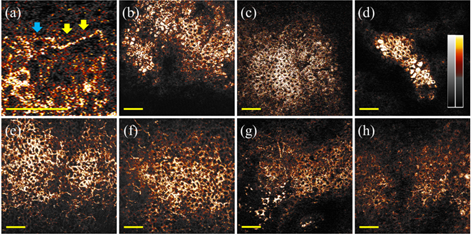 |
|
Fig.2 Representative in vivo THG human skin images with different melanocyte dendricity scores (MDS) in melsam patients. (a) A typical melanocyte in the THG human skin image with a cell body (blue arrow) and an obvious long dendrite (yellow arrow). (b)(c)(d) Examples of THG human skin images with the lowest MDS equivalent to 0. (e)(f)(g)(h) Examples of THG human skin images with the highest MDS equivalent to 3. Scale bar = 50 µm |
|
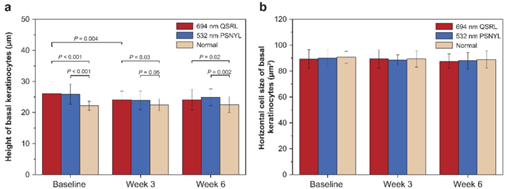 |
|
Fig.3 Morphological parameters relevant to basal keratinocytes in SLs patients. The (a) HBK and (b) HCS of basal keratinocytes were analyzed from the en face in vivo HGM images at baseline, week 3, and week 6. Statistical differences were tested using the paired t-test. PSNYL: picosecond Nd:YAG laser; QSRL: Q-switched ruby laser; HBK: height of basal keratinocytes; HCS: horizontal cell size; HGM: harmonic generation microscopy. |
Reference:
[1] Sun, C. K., Wu, P. J., Chen, S. T., Su, Y. H., Wei, M. L., Wang, C. Y., ... & Liao, Y. H. (2020). Slide-free clinical imaging of melanin with absolute quantities using label-free third-harmonic-generation enhancement-ratio microscopy. Biomedical Optics Express, 11(6), 3009-3024.
[2] Wei, M. L., Liao, Y. H., Weng, W. H., Shih, Y. T., Sheen, Y. S., & Sun, C. K. (2021). A Study on Applying Slide-Free Label-Free Harmonic Generation Microscopy For Noninvasive Assessment of Melasma Treatments With Histopathological Parameters. IEEE Journal of Selected Topics in Quantum Electronics, 27(4), 1-10.
[3] Wu, P. J., Chen, S. T., Liao, Y. H., & Sun, C. K. (2021). In vivo harmonic generation microscopy for monitoring the height of basal keratinocytes in solar lentigines after laser depigmentation treatment. Biomedical Optics Express, 12(10), 6129-6142.
Dual-depth Augmented Reality Head-up Display with Holographic Imaging
Professor Hoang-Yan Lin
Graduate Institute of Photonics and
Optoelectronics, National Taiwan University
臺灣大學光電所 林晃巖教授
Head up displays (HUDs) show useful information on a combiner or windshield of a vehicle so that drivers do not need to look down on their dashboards and can focus on the road. As HUDs are proved to increase drivers’ safety and driving experience, HUDs have become more popular over the past decade. Conventionally, head up displays use liquid crystal displays (LCDs) as their picture generation units (PGUs). Most commercial HUDs are LCD-based and project a single image on its combiner. However, as the concept of augmented reality and virtual reality have become well-known and popular, with the upgraded computational speed and performance, augmented reality head up displays (ARHUDs) have become the future of HUDs.
Compared to traditional HUDs, ARHUDs can be designed to provide at least two virtual images with different depths, with at least one virtual image interacting with real world, so that drivers can have immediate reaction without visual conflicts. A straightforward method to realize this concept is to use two or more LCDs as PGUs and corresponding imaging optics to produce several virtual images at different depths. However, this method requires much more cost and volume, which makes it unsuitable for the scenario of HUDs.
As shown in Fig. 1, we develop a dual-focal-plane ARHUD based on holographic imaging, which allows dynamic depths of reconstructed images by varying the modulation of a spatial light modulator (SLM), e.g. liquid crystal on silicon (LCOS). With holographic imaging system in replace of LCDs as PGUs, A single freeform mirror is designed to further magnify the projection sizes and depths, which fits the simultaneous projection of two separated images, reconstructed at two different depths by holographic projection system, producing a far image (15° x 3° at 7 m) and a near image (6° x 2° at 2.5 m), as shown in Fig. 2, in an eyebox of 100 mm by 60 mm. An algorithm on distortion correction based on Code V analysis also shows effective result of correcting the complex and non-radial distortion of freeform off-axis optical system.
|
 |
|
(a) Illustration of the specifications. |
|
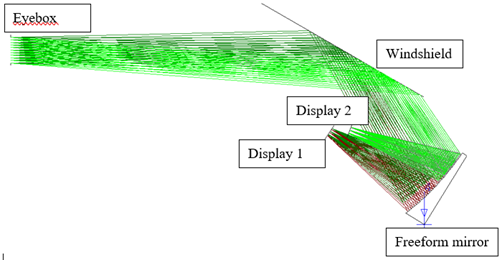 |
|
(b) Layout or magnification of highlighted portion in (a). |
|
Fig. 1. Specification and layout of the HUD. |
|

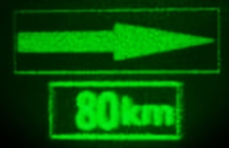 |
|
(a) (b) |
|
Fig. 2. Holographic reconstruction of two images with two different depths (a) focused at the near icon, 80 km; (b) focused at the far icon, arrow. |
Reference:
I-Chen Cho, You-Ming Hu, Chih-Hao Chuang, Chi-Wen Lin, Kuan-Hsu Fan-Chiang, and Hoang-Yan Lin, Dual-depth Augmented Reality Head-up Display with Holographic Imaging, 3DSA 2021.
|
 |
| |
|
|
|
 |
|
| |
|
 |
論文題目:可撓性氧化物半導體放大電路及其於生物訊號感測之應用
姓名:許書銘
指導教授:陳奕君教授
| 摘要 |
|
可撓性電子(flexible electronics)技術因具有輕、薄,以及可彎曲等特性,是實現肌膚電子(skin electronics)產品的關鍵技術。目前大多數可撓性電子元件皆製作於塑膠基板上,考量塑膠所能承受之製程溫度,能在相對低溫下製造的氧化物半導體(oxide semiconductor),是適合開發可撓性電子元件的半導體材料。本研究首先於聚醯亞胺(polyimide)基板上開發P型氧化亞錫(tin monoxide)和N型氧化銦鎵鋅(indium gallium zinc oxide)薄膜電晶體(thin-film transistor),並結合原子層沉積系統之覆蓋效應(atomic-layer-deposition capping effect),優化電晶體之電性表現。接著,整合氧化亞錫和氧化銦鎵鋅薄膜電晶體開發CMOS反相器(complementary metal-oxide-semiconductor inverter),透過調整CMOS的結構和製程之優化,成功使CMOS反相器的靜態電壓增益於供應電壓10 V時能超越300 V/V,同時元件展現優異的彎曲可靠性,不論是在受到張應變還是壓應變的情況下,即便彎曲半徑小至2.5 mm,整體電性皆無明顯之變化。透過此可撓性CMOS技術,我們成功製作了CMOS差分放大器,其差模增益值、共模增益值,以及共模互斥比分別約為51 V/V、8.5 V/V和15.6 dB。最後將市售之心電量測電極貼附於胸口,並連接至可撓性CMOS差分放大器,成功讀取到了心電訊號,此結果證明了所開發之基於氧化物半導體的可撓性電子技術,在具有生物訊號監測功能之肌膚電子產品上的應用潛力。
|
 |
|
圖一、可撓性CMOS反相器的(a)示意圖及(b)照片。[1] |
|
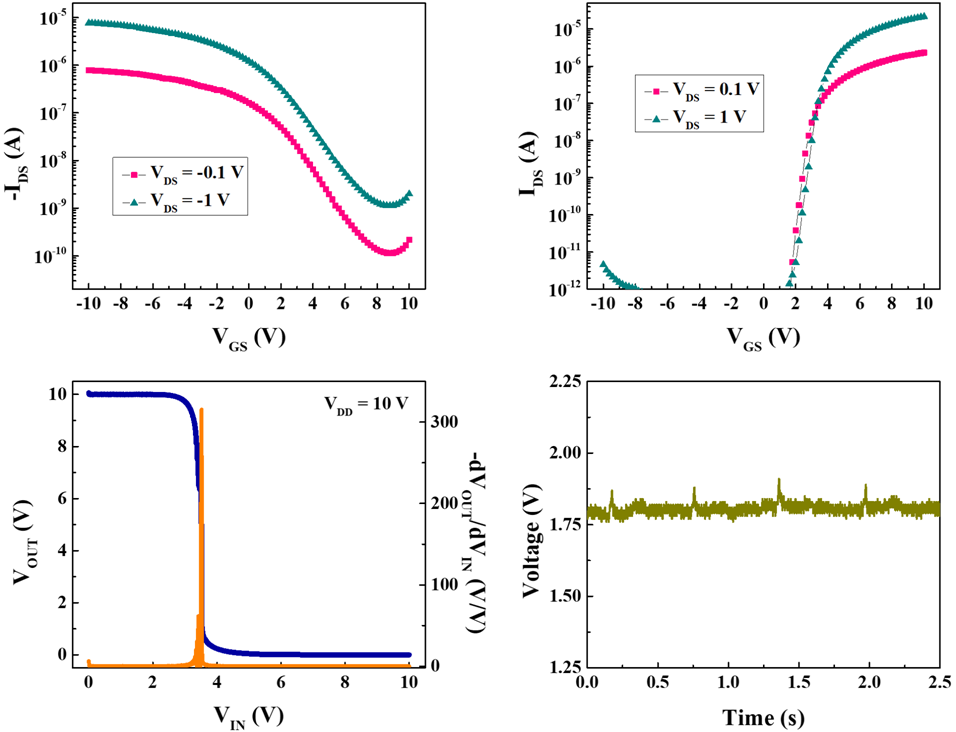 |
|
圖二、可撓性(a)P型氧化亞錫和(b)N型氧化銦鎵鋅之轉換特性曲線。(c)可撓性CMOS反相器之電壓轉換特性。(d)透過可撓性CMOS差分放大器所得到之心電訊號。 |
Reference:
[1] S.-M. Hsu, D.-Y. Su, F.-Y. Tsai, J.-Z. Chen, and I.-C. Cheng, “Flexible complementary oxide thin-film transistor-based inverter with high gain,”
IEEE Trans. Electron Devices, vol. 68, no. 3, pp. 1070-1074, Mar. 2021, doi: 10.1109/TED.2021.3052443. |
|
 |
|
 |
|
| |
|
 |
—
資料提供:影像顯示科技知識平台 (DTKP, Display Technology
Knowledge Platform) —
—
整理:林晃巖教授、吳思潔 —
太赫兹波之相位控制移往晶片上
太赫茲(Terahertz , THz)輻射,通常稱為T波,在微波和紅外波段之間的電磁頻譜中佔據獨特的位置。隨著頻率範圍從0.1到10 THz,T波在無線電天文學(radio astronomy)和太空科學(space science)中一直是很重要的。然而,隨著檢測器發展的進步,最重要的是太赫茲輻射源在光譜學、材料特性檢測、遙測和診斷、成像和斷層掃描[1]等應用上,促進了在研究實驗室和工業中對於使用T波的更廣泛興趣;特別是對於生命科學和醫學方面,T波有很大的希望,因為許多生物之重要大分子的集體振動是發生在太赫茲頻率的範圍[2]。此外,太赫茲頻率範圍被考慮作為下一代高速數據運行的短距離無線系統,並可以與光纖通訊系統銜接 [3]。
然而,因為缺乏用於動態控制和調制T波的高效率和緊湊元件,THz技術的發展及其採用一直受到阻礙,這一功能仍然是一個關鍵挑戰[3]。困難主要是因為T波與天然非金屬材料的交互作用很弱,除了最值得注意的摻雜半導體和極性液體(像是水),而它們僅僅是被吸收。
目前採用的主流解決方案之一是提升T波與物質間的相互作用,特別是透過利用人工工程材料,所謂的超穎材料(metamaterial)[4]的電磁共振。這種方法已經能夠演示基於主動超穎材料的元件,例如用於T波在自由空間中作為準直或聚焦光束傳播的開關和調制器,(例如參考文獻[5]-[7])。 然而,迄今為止,這類設計還不能輕易縮小到在太赫茲通信中的晶片級生物醫學感測器和數據處理系統[3],其所設想之積體化太赫茲元件的尺寸,更別提新興太赫茲電子產品所需的微型化程度了。
現在Nature Photonics中報導了,Hongxin Zeng及其團隊設計並透過實驗驗證了太赫茲電路的一個重要元件—晶片上的一種緊湊型高精度電子移相器(phase shifter),它能夠對T波進行可變數位編碼相位調制[9]。所演示的相位編碼晶片的其他顯著特點是它實際上不會影響T波的振幅。此外,它展現出低傳輸損耗(不同於以前利用共振相互作用的解決方案)。
相位編碼晶片(如圖一)是基於傳統微帶波導,其中一側透過微製造的平面電容器連接到一系列沿波導等距分佈的六個相同的短金屬貼片。在大約 0.3 THz 的頻率下,由此產生的微結構(在微波工程中稱為短截線(stub))作為微型電磁諧振器,每個諧振器都會局部改變波導的阻抗,因此影響引導T波的傳播。它們代表了太赫茲頻率範圍,等效於電子學中常見的LC諧振電路,而LC諧振電路在如此高的頻率下是不可能實現的。由於短截線的諧振是來自駐波的激發,因此可以透過改變短截線的有效電長度來改變諧振的頻譜位置(以及它在特定頻率造成的振幅變化)。作者透過使短截線中的微電容器可藉由各自的短截線單獨提供的控制信號,進行數位切換來實現這一點。結果,他們能夠將任何給定短截線的共振進行藍移高達20%。
|
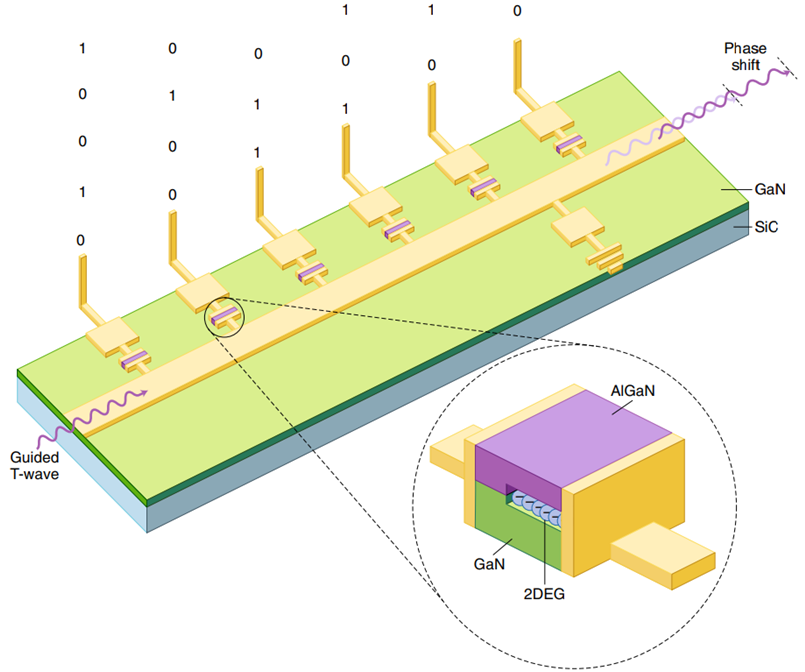 |
|
圖一、太赫兹移相晶片的原理圖,及其如何將數位編碼相位調制傳遞給沿中心波導傳播的T 波。相移是通過沿波導上側放置的短截線引入的,並充當由具有二維電子氣(2D electron gas, 2DEG)的微電容器控制的微小太赫茲諧振器。 |
AlGaN/GaN的異質接面(跨越他們的間隙)整合至微電容器的結構是實現大的頻譜偏移的關鍵。已知一個AlGaN/GaN的異質接面會自行產生二維電子氣(2D electron gas, 2DEG),兩種材料之間的界面處捕獲的單層密集電子[10]。2DEG中的電子可以沿著表面自由移動,有效地形成了一個導電片,它幾乎完全連接了從一塊平板延伸到另一塊平板的製造微電容器中的間隙(見圖一)。透過間隙施加偏壓,可以使2DEG更進一步遠離平板之一,從而降低結構中的電容。作者發現將偏壓從0 V(狀態“1”)切換到 7 V(狀態“0”)後電容降低了十倍以上。
為避免T波的振幅變化,會伴隨著電子控制的諧振短截線引起的相位變化,Hongxin Zeng及其團隊選擇在頻率範圍為0.26–0.27太赫茲、非諧振的狀態運行他們的晶片。
這種技巧使他們能夠將晶片的整體傳輸維持在相對較高的水準(–6到–8 dB,取決於頻率),波動僅限於0.5 dB。儘管在此頻率範圍內透過任何單個短截線獲得的相移自然小於諧振時(低於10度),但它會隨著導波從一個短截線傳播到另一個短截線而累積,並可能高達55度。重要的是,短截線單獨施加的相移不會僅僅由於後者之間的相互作用而累加,這使得許多(其他等效的)開關組合顯得獨一無二。例如,輸入代碼 100001、010010和001100給晶片將產生不同的相移。為了完全解除簡併態(degeneracy),Hongxin Zeng及其團隊使用了另一個技巧—將控制信號的接地電極作為額外的“無源”短截線引入,他們將其放置在微帶的另一側,更靠近其末端(圖一)。微帶產生的結構不平衡能確保所有控制短截線,即使單獨切換,對引導 T波也有獨特的影響—即代碼 100000、010000、001000、000100、000010、000001 將編程不同的相移。上述所有代碼1的狀態將對應至不同的輸出。
實施的方法效果很好,使作者能夠以數字方式控制 T 波的相位,並且將它以2-5度(取決於操作頻率)的小恆定增量偏移,平均誤差僅有0.36度。假設一個基於2DEG 的微電容器的開關時間非常短為100 fs,相位編碼晶片的調制速率可能高達 3 Gbps,正如最近的一項研究表明的那樣[11]。這種高速結合小尺寸晶片(主動區面積為2.3×0.3 mm2)及其“數位化就緒”,使得演示的移相器作為未來積體化太赫茲系統的主動元件特別地有吸引力。
然而,它的實際使用可能仍會被一些留著的問題延遲。特別像是移相器的操作本質上是窄帶的,因為它(雖然不是直接)依賴諧振,因此最小以及總可達到的相移兩者都取決於工作頻率。預計晶片的傳輸損耗與活性短截線的數量成比例增加,這會限制所提出的相位調制方案的擴展性,實際上,目前展示最大相移30-55度是可能的最佳輸出。最後,目前已經針對太赫茲頻帶的低頻邊緣演示了晶片上主動式的相位控制,同時對於在1太赫茲及以上的頻率振盪的T波,是否能實現相同的工作原理還有待觀察。
|
參考資料: |
Vassili Fedotov, “Phase control of terahertz waves moves on chip,”
Nature Photonics 15,
715-716 (2021)
https://doi.org/10.1038/s41566-021-00887-8
DOI: 10.1038/s41566-021-00887-8
|
|
參考文獻: |
[1] Ferguson, B. & Zhang, X. C.Nat. Mater.
1, 26–33 (2002).
[2] Liu, W. et al.
Front. Lab. Med. 2, 127–133 (2018).
[3] Tonouchi, M.
Nat. Photon. 1, 97–105 (2007).
[4]
Fedotov, V. in Springer Handbook of Electronic and Photonic Materials 2nd edn (eds Kasap, S. & Capper, P.) Ch. 56, 1351–1375 (Springer, 2017).
[5]
Chen, H. T. et al. Nature
444, 597–600 (2006).
[6]
Savo, S., Shrekenhamer, D. & Padilla, W. J.
Adv. Opt. Mater. 2, 275–279 (2014).
[7] Pitchappa, P. et al. Adv. Mater. 31, 1808157 (2019).
[8] Sengupta, K., Nagatsuma, T. & Mittleman, D. M. Nat. Electron.
1, 622–635 (2018).
[9] Zeng, H. et al. Nat. Photon. https://doi.org/10.1038/s41566-021- 00851-6 (2021).
[10] Ibbetson, J. P. et al. Appl. Phys. Lett. 77, 250–252 (2000).
[11] Zhao, Y. et al. Nano Lett.
19, 7588–7597 (2019).
|
|
|
|
|
|
 |
|
|
|
|
|
|
|
|
|
|
|
 |
|
|
|
 |
|
 |
|